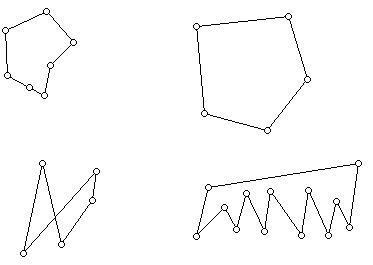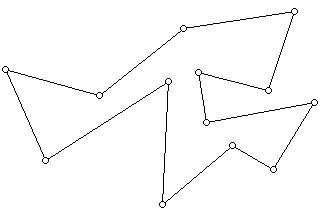
Practice 2: Polygons
Prepared by:
Joseph Malkevitch
Department of Mathematics and Computer Studies
York College (CUNY)
Jamaica, New York
email:
malkevitch@york.cuny.edu
web page:
http://www.york.cuny.edu/~malk/
1.
a. Which of the diagrams below represent polygons?

b. Which if any of the diagrams is convex?
c. How many sides does each figure below (and above) which is a polygon have?
2.
a. Draw a convex 5-gon.
b. Draw a non-convex 5-gon.
c. Draw a self-intersecting hexagon.
d. Draw a convex 7-gon all of whose sides have equal length but for which not all the angles are the same size.
3.
a.
A diagonal of a polygon drawn in the plane is a line segment which joins two vertices of the polygon and lies completely in the interior of the polygon.

How many different diagonals does the polygon above have?
b. Can one subdivide the interior of the polygon above into triangles by drawing diagonals? If so, how diagonals did you need and how many triangles did you get?
c. How many sides does the above polygon have?
d. Draw a convex polygon with the same number of sides as the polygon above.
e. Answer parts (a) and (b) of this question for the polygon you draw in (d).
f. An ear of a plane simple polygon is a vertex E with the property that the line segment joining the endpoints of edges that meet at E is a diagonal of the polygon.
How many ears does the polygon above have? Can you find an infinite family of polygons where each polygon in the family has exactly 2 ears?
4, A reflex angle of a polygon drawn in the plane is an interior angle of the polygon whose measure is more than 180 degrees.
a. Can you draw a quadrilateral with a reflex angle?
b. Can you draw a pentagon with two reflex angles?
c. Can you draw a hexagon with two reflex angles?
d. An equilateral polygon (drawn in the plane) is one all of whose sides have the same length. An equiangular polygon (drawn in the plane) is one all of whose interior angles are equal.
Can you draw either an equiangular or equilateral quadrilateral with a reflex angle?